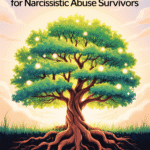Invisanarcs Covert Control
- Home
- Invisanarcs Covert Control
Invisanarcs
When the Narcissist Isn’t a Person — It’s the System
Invisanarcs = Systemic Narcissism
Narcissistic abuse doesn’t always have a name, a face, or a single source.
Sometimes, it shows up as healthcare systems that dismiss your pain, government processes that punish your vulnerability, or policies designed to break you, not support you.
These are the Invisanarcs — institutions, industries, and bureaucracies built on control, ego, and power hoarding.
And surviving them requires just as much clarity, strategy, and self-trust as surviving any individual narcissist.
What Is Systemic Narcissism?
Systemic narcissism is when structures and systems mirror the same traits found in narcissistic individuals:
🎯 Lack of empathy
🎯 Grandiosity or superiority
🎯 Exploitation of power
🎯 Denial of accountability
🎯 Gaslighting and manipulation
🎯 Prioritization of image over substance
🎯 Punishment of boundaries or resistance
It’s when your pain becomes paperwork.
Your advocacy is labeled “aggression.”
And your silence is the only thing they reward.
🚨 Where Invisanarcs Show Up
🏥 Healthcare
- Your symptoms are dismissed or minimized
- You’re labeled “noncompliant” when you ask questions
- Mental health concerns are ignored or weaponized
- Diagnoses are gatekept based on bias or ego
- The system protects itself — not the patient
🧾 Bureaucracy & Government
- You’re blamed for not “doing the paperwork right”
- Systems are designed for punishment, not prevention
- “Help” is conditional, confusing, and delayed
- People in power use policy to hide apathy and maintain control
🏫 Education, Work, and Housing
- Your accommodations become liabilities
- Speaking up makes you the problem
- Gatekeepers thrive while truth-tellers burn out
- Institutions silence harm to protect reputation
🧃 Why It Feels So Familiar
Systemic narcissism creates the same emotional response as personal abuse:
- Confusion
- Helplessness
- Rage with nowhere to go
- The urge to explain, fix, or beg for fairness
You’re not “too sensitive.”
You’re interacting with structures that gaslight, punish, and dominate by design.
🧩 How to Navigate Invisanarcs
1. Name It
Language is power. Call the dynamic what it is. You’re not being “difficult” — you’re encountering institutional gaslighting.
2. Document It
Screenshots. Emails. Journals. Logs. Systems protect themselves — keep receipts.
3. Regulate Yourself First
Invisanarcs feed off distress. Stay grounded. Don’t let them push you into survival mode. That’s where they win.
4. Use Allies, Not Appeals
If you can’t fight the system alone, don’t. Use advocates, legal aid, ombudspeople, or whistleblower resources.
5. Focus on Impact, Not Approval
You might never get an apology. The goal isn’t validation — it’s liberation.
🔒 Why Survivors of Narcissistic Abuse See It First
If you’ve survived a narcissist, you already know the playbook.
That “gut feeling” that something’s off? Trust it.
That sense of being treated like a problem, not a person? That’s not paranoia — that’s the pattern.
Survivors often see systemic abuse clearly — because we’ve already lived it on a smaller scale.
💬 Final Word
The gaslighting didn’t stop with your ex, your parent, or your boss.
It just got an office, a policy manual, and a customer service line.
But now, you can name it.
You can document it.
And most importantly — you can stop internalizing it.
Invisanarcs want your silence.
You’ve already given too much.
Now? You give it a name.
















